
 |
Search | FAQ | US Titles | UK Titles | Memories | VaporWare | Digest | |||||||
| GuestBook | Classified | Chat | Products | Featured | Technical | Museum | ||||||||
| Downloads | Production | Fanfares | Music | Misc | Related | Contact | ||||||||
| JP1 Universal Remotes for the SGT250 and SJT300 | ||||||||||||||
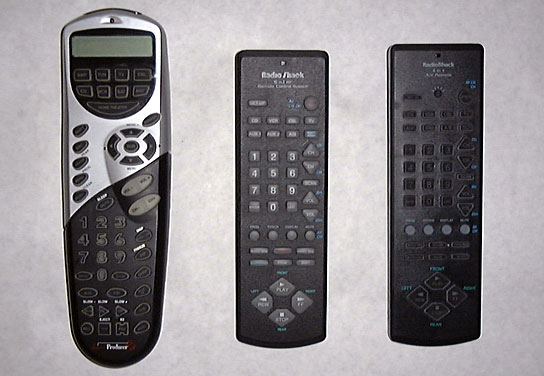
This page describes the discovery of a select few universal remotes from the mid 1990's capable of controlling the SGT250, SJT300, SKT300, and 686-5705 CED players, and how that discovery led to the knowledge necessary to modify a wide range of universal remotes to control the above players.
For a long time I didn't think there were any universal remotes capable of controlling these early IR-remote CED players. This was based on my own experimentation and the analog method these early IR remotes use to generate the IR signal. But that all changed when I received an email from fellow CED collector Sean Meskill stating his RadioShack 15-1918 Six-in-One remote could control his SGT250 when LaserDisc code 128 was programmed into the unit. Now it turns out I had been using a RadioShack 15-1905 Six-in-One remote from the early 1990's to control my RCA PFR100 television, so it seemed plausible that these remotes could control CED players. But alas, there were no codes for the 15-1905 that could accomplish this. I next tried a recent RadioShack 15-2104 Six-in-One remote and again found it had no codes for CED player control. This led Sean and I to speculate that his SGT250 may have been specially modified, as the player appeared to have been tampered with, and it made no sense for RadioShack to make a Six-in-One remote in the mid 1990's providing CED player control when Six-in-One remotes before and after that time lacked this capability.
And so it stood until I eventually found a RadioShack 15-1919 Six-in-One remote (at center above) on eBay that looked nearly identical to the 15-1918 (at right above). I purchased this, and soon discovered that like Sean's 15-1918, it could control an SGT250 when LaserDisc Code 128 was programmed into the unit. The remote owner's manual lists two RCA LaserDisc codes, 128 and 351, and it turns out that 351 truly is a LaserDisc code that when programmed into the remote allows it to control RCA-branded LaserDisc players from the 1990's. So my theory is that in the mid-1990's the engineers programming these remotes came across an SGT250 VideoDisc remote and reverse-engineered a coding scheme for it, thinking the remote was for an earlier RCA LaserDisc player. When they later discovered this coding was for the defunct CED format, the coding was removed from Six-in-One remotes, and references to "LaserDisc Code 128" disappeared from the owner manuals. But read on to learn how the fact that this coding was once created means it still exists today and can be transferred to modern remotes.
Research revealed that RadioShack has these Six-in-One remotes manufactured for them by Universal Electronics, a company that markets its own line of remotes under the name brand One For All. Looking through the owner's manuals this company has on-line, I learned that the manual for the URC-8090 Home Producer lists the RCA "LaserDisc 128, 351" codes, so I set up an eBay search on this remote to acquire one and see if it too could control CED players. When one turned up, I found this was indeed the case, although the selection of search buttons on the remote is odd and Pause isn't directly available from code 128. This remote also has a six-pin connector on the bottom labeled "JP1" that brought back a memory of an article I had once read on the web. A simple search on the term JP1 led me to an entire Internet sub-culture devoted to the JP1 interface, and as soon as I posted a message on the JP1 Forum asking about LaserDisc Code 128, the forum leader, Rob Crowe, extracted the code. This makes it available for upload to any remote having a JP1 connector.
In simple terms JP1 allows the coding in an IR remote to be downloaded and saved to a computer attached to the remote by a special JP1 cable. The coding can then be modified and uploaded into that same remote or a different one. JP1 uses a freely available program to handle the data transfer and an Excel worksheet to view and modify the code. So all you need to get started with JP1 is the JP1 cable, a JP1 remote, a PC-compatible computer, and the Excel spreadsheet program. There is also a Java application called RemoteMaster that eliminates the need for Excel. That's about all the further I'll describe JP1 here, as the links at the bottom of this page provide access to the vast amount of JP1 info already out there on the web.
But Rob Crowe at HiFi Remote had made things even easier for those CED collectors who just want an SGT250/SJT300 remote without getting into the intricacies of the JP1 interface. He has a Marketplace page listing the JP1 remotes available for purchase, and upon request he will transfer the SGT250/SJT300 coding into the remote for free before shipping the remote out. The One For All company has started taking the six-pin connector out of their stock remotes, so the units Rob sells have been modified by soldering this six-pin header back into the remote. Rob also sells ready-made JP1 cables. In addition to JP1 coding for SGT250/SJT300 CED players, there is also a JP1 code for the Hitachi VIP201P, a PAL-format player marketed in the United Kingdom.
The pictures below provide more details on the RadioShack and One For All remotes I have acquired on eBay. Also detailed is the URC-6011 remote I purchased from Rob with the CED code programmed into it. My thanks go to Rob for providing this service. And thank you Sean Meskill for discovering your 15-1918 remote controls your SGT250 player. Without that discovery, knowledge of these SGT250/SJT300 remote options might have forever been unknown to the CED community.
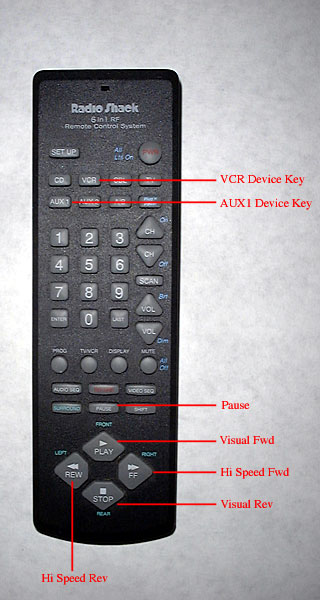
|
RadioShack 15-1919 Remote Control
This is the first remote I acquired on eBay that is capable of controlling the SGT250/SJT300 CED players when "LaserDisc Code 128" is programmed into either the VCR or the AUX1 Device Keys. The 15-1919 Manual provides details on how to program the code into the remote. Once programmed, operation of the unit as an SGT250/SJT300 remote is pretty intuitive, as the Pause button on the remote initiates Pause on the player, and the four large buttons at the bottom of the remote initiate the search functions of the player. The 15-1918 is programmed in the same fashion with the same five keys controlling the CED functions. |
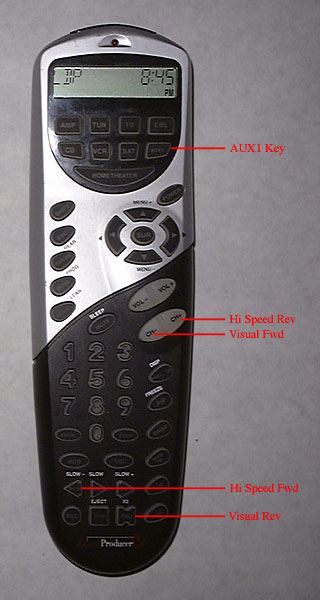
|
One For All URC-8090 Remote Control
This is the Home Producer 8 Remote made by One For All, which will control SGT250/SJT300 CED players when "LaserDisc Code 128" is programmed into the AUX1 Device Key. The URC-8090 Manual provides details on how to program the code into the remote. This unit isn't nearly as intuitive to operate as the RadioShack remotes, since the button selection is odd, and the high speed and visual search functions are not properly paired on the buttons chosen. But there are ways to shift the button functions around, even without a JP1 interface. The similar URC-8080 remote also uses the "LaserDisc Code 128." |
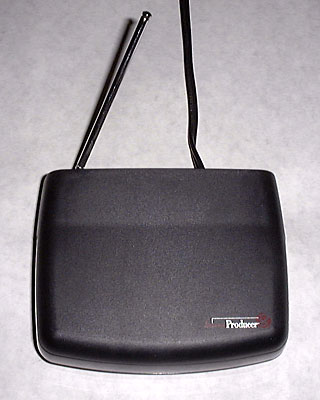
|
One For All URC-8090 Command Center
The URC-8090 and RadioShack 15-1919 are both Infrared and RF remotes. They came with this Command Center box that receives a Radio Frequency signal from the remote and translates it into an IR signal. This box was intended to be placed in front of an entertainment console so the remote could be used to control all devices in the console from any room of the house. These remotes came out in 1997, when it was common for a household to have a single satellite receiver but the desire to have its signal viewable and controllable in more than one room. So these remotes touted that capability. Today, most satellite systems come with four receivers, so the need to farm-out a single signal has been diminished. |
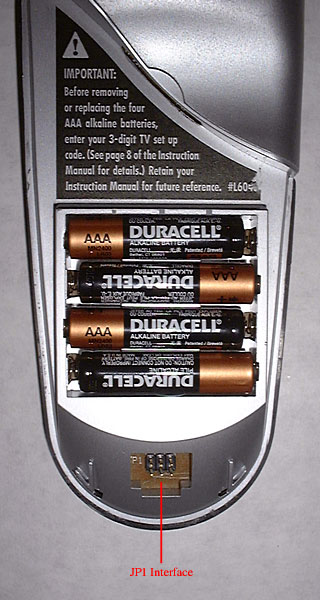
|
Six-pin JP1 Interface
This is the JP1 interface on my eBay-acquired URC-8090 whose presence led me to the JP1 folks on the Internet. The RadioShack remotes also have a JP1-compatible connector, although it's not in this standard six-pin configuration. The URC-8090 came out in 1997, and since that time the One For All company has started removing the convenient six-pin header, presumably to make it harder for people to fiddle with JP1. But the solder pads are usually still there, so a six pin header can be soldered in place provided you are comfortable with soldering and disassembling the remote. Or you can simply purchase a remote with the JP1 header already soldered in from Rob's Marketplace. |
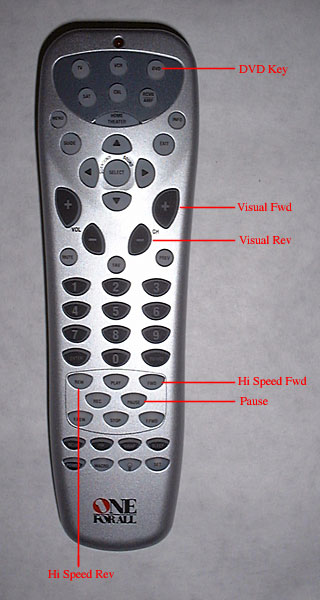
|
One For All URC-6011 Remote Control
This is the URC-6011 I purchased from Rob Crowe with a JP1 header added in and the SGT250/SJT300 code already programmed into the DVD Device Key. As mentioned previously, Rob is happy to program this code, at no cost, into any JP1 remote purchased from him. His supply of URC-6011 units is gone, but similar models are available. |
Here are eBay searches for the specific remotes that I've acquired on eBay directly supporting the SGT250/SJT300 CED players. These searches are very focused and require the seller to list the remote model number in the auction. You may want to devise your own broader searches including terms like "One For All" and "Radio Shack" to get more matches. Note that these remotes don't turn up often, so it may be easier to buy a modern remote from Rob's Marketplace with the SGT250/SJT300 code already programmed in.
Here are some more eBay searches for other remotes that may support the SGT250/SJT300 CED players. I haven't personally acquired or tested any of these models, but they do contain the LD/0128 coding. Note that the RCU810 has its coding offset by 17, so LD/0128 would be programmed by entering LD/0145.
Here are a number of links to information on the JP1 interface that allows a variety of universal remotes, including the most recent models, to control the SGT250/SJT300 players. There is a learning curve for this, so start with the "JP1 for Beginners" link to get up to speed quickly:
Rob's Remotes - Extensive Information on One-For-All and RadioShack Remotes
JP1 Forum - Supercedes the Yahoo Group for On Going JP1 Discussion
These are the code files for the SGT250/SJT300 (including the SKT300 and 686-5705) that can be uploaded into a universal remote with a JP1 interface. Copy the complete text contents of each page, paste it into a plain text file, and upon saving that file, it's ready for upload to your universal remote: